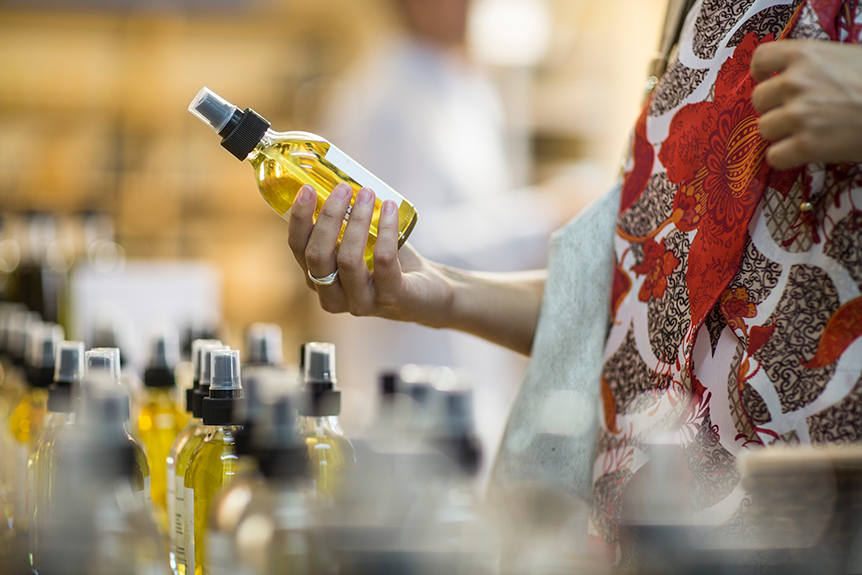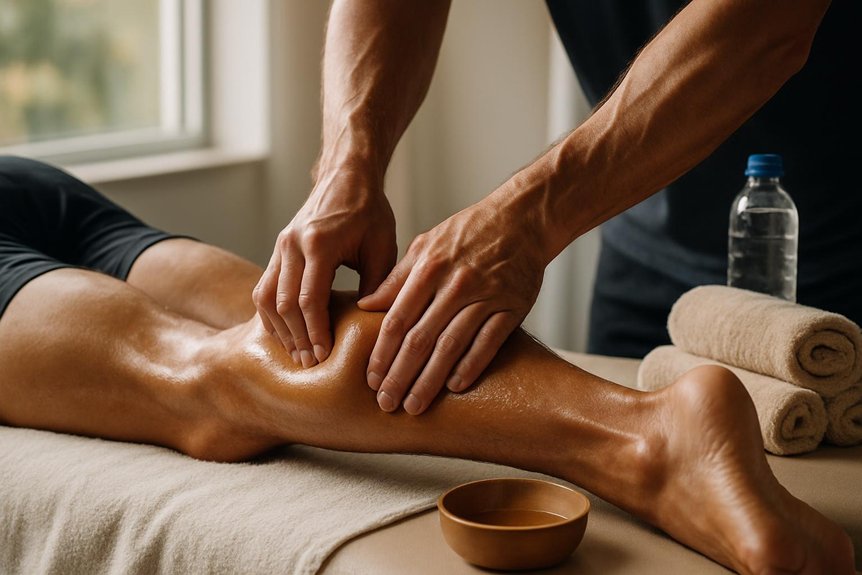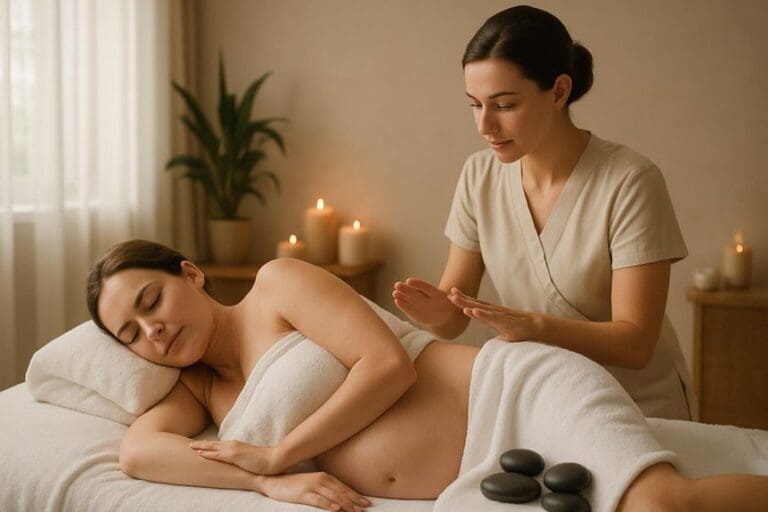Athletic massage begins with client assessment and identification of musculoskeletal concerns, followed by targeting anatomical landmarks and preparing a safe, comfortable environment. Techniques like effleurage and petrissage manipulate superficial and deep muscle layers, while trigger point therapy addresses hypertonic bands for ideal neuromuscular recovery. Pressure is adjusted according to tissue response, and aftercare, including hydration and rest, is essential for proper recovery. For a step-by-step guide, further information is available below.
Understanding the Purpose of Performance Massage

Why is sports massage essential for athletes and active individuals?
Performance massage targets musculoskeletal health by manipulating soft tissues—muscle fibres, fascia, tendons—to support ideal biomechanics. The therapy aims to enhance circulation, facilitate lymphatic drainage, and reduce microtrauma-induced adhesions.
At Spa & Massage, therapists apply specific techniques to address muscle imbalances, relieve hypertonicity, and promote neuromuscular recovery. Regular intervention can minimise delayed onset muscle soreness (DOMS) and mitigate risk of repetitive strain injuries.
Anatomical precision is fundamental; the therapist must understand origin, insertion, and function of each muscle group involved. Safety is prioritised through continuous assessment of tissue response, ensuring techniques align with the athlete’s physiological state.
This careful, informed approach fosters trust and allows clients to experience not only physical relief but a profound sense of care. Some techniques used within performance massage overlap with deep tissue massage methods, offering further benefit by addressing chronic muscle tension and supporting long-term musculoskeletal health.
Preparing for a Performance Massage Session
Effective performance massage begins with thorough preparation to optimise therapeutic outcomes and maintain client safety.
At Spa & Massage clinics, therapists initiate each session with a detailed consultation, gathering information about the client’s medical history, current musculoskeletal concerns, and any contraindications.
Anatomical landmarks are identified to guide targeted work, and areas of tenderness, inflammation, or restriction are carefully noted.
The environment is set to promote both physical and psychological comfort—adjusting table height for ergonomic alignment, regulating room temperature, and selecting hypoallergenic oils suited to skin sensitivities.
Clear communication outlines session boundaries and reassures the client of privacy and respect.
This structured approach ensures that individual needs are met while minimising risks, fostering a sense of trust and intimacy essential for effective therapeutic engagement.
Essential Techniques Used in Performance Massage
Performance massage at Spa & Massage incorporates fundamental techniques such as effleurage and petrissage, which target superficial and deep muscle layers to enhance circulation and tissue pliability.
Trigger point therapy is also employed to address localized areas of muscular hypertonicity, often found within myofascial bands.
Therapists prioritize anatomical accuracy and client safety, adjusting pressure and technique based on individual musculoskeletal responses.
Effleurage and Petrissage Movements
How are foundational manual therapy techniques applied to optimise tissue function during performance massage? Effleurage and petrissage movements form the cornerstone of effective performance massage, frequently utilised by Spa & Massage therapists.
Effleurage employs long, gliding strokes along the direction of muscle fibres, targeting the superficial fascia and enhancing venous and lymphatic return. This technique induces relaxation, gently warms the tissues, and prepares the musculature for deeper manipulation.
Petrissage involves kneading, rolling, and lifting of the soft tissues, directly affecting the underlying muscle bellies and connective tissue interfaces. Through petrissage, therapists facilitate improved circulation, mobilisation of metabolic waste, and release of minor adhesions.
At Spa & Massage, safety is prioritised—each movement is performed with anatomical precision, respecting client comfort and tissue integrity throughout the therapeutic process.
Trigger Point Therapy
Building upon the foundational techniques of effleurage and petrissage, trigger point therapy addresses localized areas of hyperirritability within skeletal muscle, commonly referred to as myofascial trigger points.
These nodules are often found within taut bands of muscle fibers, eliciting referred pain patterns and functional limitations.
At Spa & Massage, therapists use precise ischemic compression and sustained pressure, targeting the neuromuscular junction to release tension and restore normal muscle tone.
Anatomical accuracy is paramount; practitioners palpate for nodular density and assess client feedback to calibrate intensity.
To prevent tissue damage, therapists gradually increase pressure and monitor for adverse reactions.
This approach not only alleviates discomfort but also enhances muscular flexibility, facilitating recovery and deepening the client’s connection to their own body’s healing processes.
Choosing the Right Massage Oils and Tools

Selecting appropriate massage oils and tools is fundamental to ensuring both the efficacy and safety of a performance massage. At Spa & Massage, therapists carefully choose hypoallergenic oils designed to reduce friction while enabling precise manipulation of myofascial tissues and deep muscle fibers. These oils facilitate smooth gliding over the skin, minimizing the risk of irritation as hands contour around the deltoids, quadriceps, or lumbar region.
For targeted work, therapists utilize anatomically contoured tools, such as massage balls or myofascial release sticks, which provide controlled pressure to dense connective tissues without causing microtrauma.
Emphasizing hygiene, all equipment is sanitized between sessions. This meticulous approach fosters a safe, nurturing environment where clients feel secure and cared for, enhancing the effectiveness of every therapeutic touch.
Step-by-Step Guide to Performing This Massage Therapy
With the appropriate oils and tools prepared, attention shifts to the systematic application of performance massage techniques. The process commences with gentle effleurage, allowing the therapist to evenly distribute oil and assess muscle tone across the targeted anatomical regions, such as the quadriceps, hamstrings, or deltoids.
Gradually, firmer petrissage and deep tissue strokes follow, directed along the muscle fibers to facilitate myofascial release and address localized tension. At Spa & Massage, therapists pay close attention to areas of increased density or sensitivity, adapting pressure to client tolerance and maintaining open communication at all times.
Specific friction and compression techniques may be employed over tendinous junctions to enhance circulation and flexibility. Throughout, safety is prioritised, with continuous monitoring for adverse responses and respect for physiological boundaries.
Aftercare and Recovery Tips for Optimal Results
How can post-massage protocols enhance musculoskeletal recovery and support physiological adaptation? Immediate aftercare is essential to optimize the effects of a performance massage.
At Spa & Massage, therapists recommend gentle hydration to facilitate metabolic waste removal and restore tissue fluid balance.
Light stretching can maintain myofascial elongation and prevent neuromuscular tightness.
Clients are encouraged to avoid strenuous activity for 24 hours, supporting microtrauma repair within muscle fibers and connective tissues.
Application of cold therapy may reduce inflammation in areas of focal tenderness.
Our therapists advise monitoring for delayed soreness or abnormal swelling, emphasizing the importance of self-awareness.
These aftercare steps, rooted in anatomical understanding and clinical safety, empower individuals to deepen their connection to their bodies and maximize the restorative benefits of professional performance massage.
Conclusion
This therapy serves as the keystone in the arch of athletic performance, supporting the musculoskeletal structure much like roots nourish a thriving tree. Through precise manipulation of fascia, muscle fibres, and connective tissues, therapists pave the way for functional resilience and recovery. By adhering to anatomical principles and prioritising safety, practitioners guarantee each session becomes a bridge—uniting preparation, intervention, and aftercare—to sustain the enduring strength and flexibility essential for every athlete’s journey.



